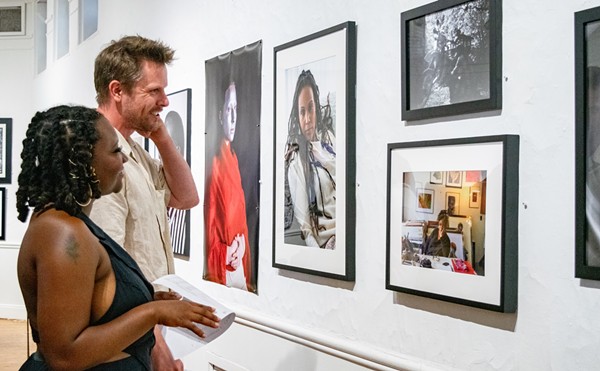Along with the 13 paintings from James Abbott McNeill Whistler (1834-1903) hanging at the Detroit Institute of Arts and 50 works from American painters who picked up on his strident “aestheticism” and “art for art’s sake” vibe is a cruel lesson in the irony of fate.
For all of Whistler’s attempts to strip his work of “meaning” and “story” and “morality,” most of us can only recall his most famous work, “Arrangement in Grey and Black, No. 1: Portrait of the Artist’s Mother,” and the myriad ways the stoic and severe image has seared itself into the fabric of American iconography. Who hasn’t gazed upon that old broad staring to the left in that uncomfortable chair and wondered what cruelties of Victorian discipline must have rained upon poor old Jimmy?
Despite Whistler’s lifetime obsession with making people see his paintings as objects of sheer beauty, his work did nothing but fuel rumors about his subjects, granting him a “mystery” he likely would have despised if he were alive to witness it.
The DIA show, American Attitude: Whistler & His Followers, does an excellent job of stripping the myths and distractions away from, “Whistler: The Man Who Painted His Mother,” to put the focus back on, “Whistler the Artist,” allowing us to see how influential and truly revolutionary his work was, not only at the time of its creation, but in its impact on the abstract and impressionistic veins of modern art.
The first gallery in the exhibit is devoted to portraits. Specifically, the gallery examines two “scandalous” works entitled “Symphony in White, No.1: The White Girl” and “Arrangement in Black & Brown: The Fur Jacket” by Whistler. Though the painter said the works should be counted merely as color arrangements, they caused much speculation, i.e., “Was Whistler banging these girls?”
“The White Girl” stands tall, holding a flower and dropping another few; her white dress and white background engulfing her rather befuddled, innocent face, which, like her hair, is “fuzzy” (read: early Impressionism). She stands upon a tiger rug. The background is shallow, guiding one’s attention to the long lines of drapery and the girl’s languid pose.
People of Whistler’s day nudged each other conspiratorially about the girl’s “afterglow”; Whistler maintained he was playing with line and color and form rather than telling a narrative tale.
“The Fur Jacket” shows another aspect of things that changed with the swipe of Whistler’s brush. The figure in the painting is turned away from the viewer, camouflaged, save her face, by darkness. Speculation at the time was this was Whistler’s pregnant mistress, explaining why she’s hiding her front from view. Whistler would have said, “It’s an arrangement in black and brown, you philistines!”
Poor guy. Making art history and all anyone wanted to know was whom he was banging. Some couldn’t care less, such as American painters Herman Dudley Murphy and William Merritt Chase, who followed Whistler’s lead.
Shown side-by-side, it’s evident Whistler’s peers couldn’t resist adding warmth and hints of “story” to their paintings. The DIA’s exhibit shows Whistler to be the purist, the one who turned his “aestheticism” into a finely honed philosophy.
The exhibit also illustrates how Whistler used Asian objects and imagery solely for their decorative purposes without any regard for their historical or cultural relevance. They’re just there for looks.
Take Whistler’s “Purple and Rose: ‘The Lange Lijzen of the Six Marks.’” It’s not supposed to be realistic, and it isn’t. It’s a painting of an Englishwoman dressed up like an Asian woman admiring an Asian vase surrounded by Asian tchotchkes great and small. It could be an advertisement for Pier 1 Imports. Frederick Frieseke’s “The Yellow Room” is a beautiful painting of another Caucasian woman dressed up as an Asian. A kimono flowing to her feet, she stands in front of a kitchen counter covered with flowers. Frieseke’s portrait suggests a story, unlike Whistler’s preoccupation with “objects” and “forms.”
Yes, there’s a room with the famed “Whistler’s Mother” (forgive me, Whistler). You will be struck by how large it is. It practically covers a whole wall. The frame belonged to Whistler as well. It looks like it weighs a ton. The painting is less monochromatic than you might imagine. There are rich browns and the mother’s cheeks are chock-full of peach and rose.
Whistler was not trying to “say” anything with the painting, other than to exhibit how the chair and the woman’s shape and the wall behind her form a gorgeous symmetry. But you can’t help speculating on their relationship. She looks old and stiff and provincial. She wasn’t. She was a huge champion of Whistler’s work and enjoyed the company of his bohemian entourage. She moved to London to be with him, after the “American” painter left for Europe at the age of 23 and never came back.
The Whistler show cleverly examines one artist and the tentacles of influence he had. If the show does nothing more, let it convince you that it is less important that “Whistler’s Mother” looks like a woman who would take great pleasure in whipping your ass with a leather strap while spouting Scripture and much more satisfying to study the perfect lines and contrasting tones and forms of an artist who became famous for all the wrong reasons.
Dan DeMaggio actually likes art. Spout off to him at [email protected]




